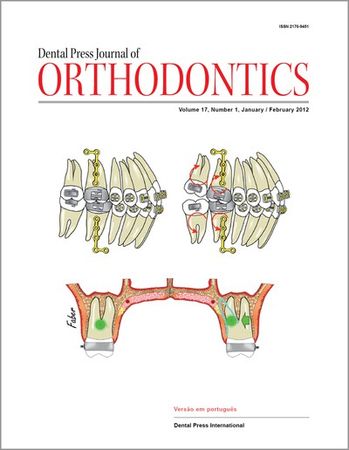A journey, I mean, a journal...
Frustration and fear of failure are crippling burdensthat can discourage one from taking the firststep on a yet unchartered course. This might explainwhy it must have been a daunting task to launch thisjournal in 1996 at a time fraught with risks and redherrings. The Furquins and their...
Autores: David Normando,
messages.RevistaAutores:
LEIA MAIS
The impact of orthodontic treatment on periodontal support loss
The increase of life expectancy and purchasingpower, along with the changes on estheticconcepts, resulted on the increase of the numberof adults seeking orthodontic treatment,combining functional benefits to smile esthetics.Because of this change, now, it is part of theorthodontist clinical...
Autores: Ana Cláudia Amoras Alves,
messages.RevistaAutores:
LEIA MAIS
Cementum, apical morphology and hypercementosis: A probable adaptive response of the periodontal support tissues and potential orthodontic implications
Information about orthodontic movement of teeth with hypercementosis is scarce. As cementumdeposition continues to occur, cementum is expected to change the shape of theroot and apex over time, but this has not yet been demonstrated. Nor has it ever beenestablished whether it increases or...
Autores: Alberto Consolaro, Leda A. Francischone, Renata B. Consolaro,
messages.RevistaAutores: Root resorption, Tooth movement, Hypercementosis, Cementum,
LEIA MAIS
An interview with Jorge Faber
Normally, we lose ourselves among the manythings we have to do. In dentistry, I know few professionalswho can skillfully combine scientific research,teaching and clinical activity. Professor Jorge Faber isone of them. In fact, he goes far beyond, gives muchof his time to deal with the arduous and...
Autores: Leopoldino Capelozza Filho, Telma Martins De Araújo, Frederico Salles, José Nelson Mucha, David Normando, David Turpin,
messages.RevistaAutores:
LEIA MAIS
Influence of the banded Herbst appliance on dental changes in mixed dentition
Objective: This prospective clinical study was conducted with the purpose of evaluating theinfluence of the banded Herbst appliance on dental changes during the early treatment ofClass II malocclusion. Method: The sample consisted of 15 prepubertal subjects (12 boysand 3 girls, initial age: 9...
Autores: Dirceu Barnabé Raveli, Ary Dos Santos-Pinto, Denise Rocha Goes Landázuri, Savana De Alencar Maia, Luana Paz Sampaio,
messages.RevistaAutores: Cephalometry, Orthodontics, Herbst appliance, Mixed dentition, Anchorage system,
LEIA MAIS
Study of tension in the periodontal ligament using the finite elements method
Orthodontic movement is process of transformation of a physical stimulation into a forceapplied to a tooth, with a biological response identified as bone remodelling. Althoughit is possible to measure the force applied on a tooth, its distribution around the rootis irregular forming areas of...
Autores: Eliziane Cossetin, Selma Hissae S. Da Nóbrega, Maria Goretti Freire De Carvalho,
messages.RevistaAutores: Orthodontics, Finite Elements Method, Tensions,
LEIA MAIS
The influence of asthma onset and severity on malocclusion prevalence in children and adolescents
Objective: The influence of asthma, its severity levels and onset time on malocclusionoccurrence were investigated. Methods: The sample was composed by 176 children/adolescents,of both genders, aged 3 to 15 years, that were divided in two groups. The asthmagroup (AG) enrolled 88...
Autores: Luiz Sekio Tanaka, Cássia Cilene Dezan, Karen Barros Parron Fernandes, Flaviana Bombarda De Andrade Ferreira, Luiz Reynaldo De Figueiredo Walter, Alcindo Cerci Neto, Silvia Fernandes Chadi,
messages.RevistaAutores:
LEIA MAIS
Assessment of the orthodontic knowledge demonstrated by dental school undergraduates: recognizing the key features of Angle Class II, Division 1 malocclusion
Objective: To investigate the ability of undergraduate students in diagnosing Angle Class IImalocclusion and evaluate the clinical approach of these students toward a patient displayingthis condition. Methods: The sample consisted of 138 students attending the last semesterof 10 dental schools...
Autores: Cátia Cardoso Abdo Quintão, José Augusto Mendes Miguel, Ione Helena Vieira Portella Brunharo, Myrna De Faria Magalhães Torres, Cristiane Canavarro, Juliana De Paiva Moura Ferreira,
messages.RevistaAutores: Angle Class II malocclusion, Diagnosis, Interceptive orthodontics,
LEIA MAIS
Assessment of soft profile characteristics in Amazonian youngsters with normal occlusion
Objective: The present study aimed to determine from a sample of Amazonian youngsters,with normal occlusion, the mean values for soft profile characteristics using cephalometricradiographs obtained in lateral norm. Methods: The cephalometric radiographsof the 30 youngsters, being 15 males and 15...
Autores: Wilson Maia De Oliveira Junior,
messages.RevistaAutores: Normal occlusion, Soft profile, Amazonians,
LEIA MAIS
Evaluation of transverse changes in the dental arches according to growth pattern: a longitudinal study
Objective: To evaluate changes in intercanine (LICW and UICW) and intermolar (LIMW andUIMW) widths on the dental arches of subjects with normal occlusion and Angle Class I malocclusionduring the transition to permanent dentition, and evaluate whether or not facial patterninfluences on the normal...
Autores: Roberto Hideo Shimizu, Aldrieli Regina Ambrosio, Ary Dos Santos-Pinto, Jucienne Salgado Ribeiro, Isabella Almeida Shimizu,
messages.RevistaAutores: Facial pattern, Transverse changes, Intercanine width, Intermolar width,
LEIA MAIS
Cephalometric deviations present in children and adolescents with temporomandibular joint disorders
Introduction: Temporomandibular disorders (TMD) have proved to be a risk factor fordeveloping hyperdivergent facial growth patterns. Objective: The aims of this studywere: (1) Assess differences between the cephalometric measurements in children witharticular TMD and a control group, before and...
Autores: Ricardo De Souza Tesch, Leticia Vilaça Willeman Bastos, Odilon Victor Porto Denardin,
messages.RevistaAutores: Malocclusion, Facial growth, TMD,
LEIA MAIS
Dental age as indicator of adolescence
Aim: The purpose of the present study was to analyze the relationship between rootformation of the first premolars and skeletal maturation stages identified in hand-wristradiographs. Methods: A cross-sectional study was carried out involving the panoramicand hand-wrist radiographs obtained on...
Autores: Omar Gabriel Da Silva Filho, Tulio Silva Lara, Francisco Antônio Bertoz, Naiara Jordão Souza Parteira,
messages.RevistaAutores: Orthodontics, Age determination by skeleton, Bone development,
LEIA MAIS
Vertical growth control during maxillary expansio
Introduction: Rapid maxillary expansion (RME) for the treatment of maxillary deficiencyand posterior crossbite may induce changes in the vertical dimension. Expanders withocclusal splints have been developed to minimize unwanted vertical effects. Objective:This preliminary study used...
Autores: Flavia Artese, Andréa Sasso Stuani, Maria Bernadete Sasso Stuani, Luciana Baptista Pereira Abi Ramia, Francisco Marcelo Paranhos Pinto,
messages.RevistaAutores: Vertical dimension, Interceptive orthodontics, Palatal expansion techniques,
LEIA MAIS
Association between nonnutritive sucking habits and anterior open bite in the deciduous dentition of Japanese-Brazilians
Objective: Assess the association between nonnutritive sucking habits and anterior openbite in the deciduous dentition of Japanese-Brazilian children. Methods: 410 children ofJapanese origin were assessed, 206 boys and 204 girls, between 2 and 6 years of age, inschools in São Paulo State,...
Autores: Daniela Garib, Hélio Scavone Jr, Rívea Inês Ferreira, Vivianne Da Cunha Barbosa Sato,
messages.RevistaAutores: Malocclusion, Deciduous dentition, Preventive orthodontics,
LEIA MAIS
Dahlberg formula – a novel approach for its evaluation
Introduction: The accurate evaluation of error of measurement (EM) is extremely importantas in growth studies as in clinical research, since there are usually quantitatively small changes.In any study it is important to evaluate the EM to validate the results and, consequently, theconclusions....
Autores: Maria Christina De Souza Galvão, João Ricardo Sato, Edvaldo Capobiango Coelho,
messages.RevistaAutores: Biostatistics, Dahlberg error, Method error, Linear regression analysis,
LEIA MAIS
Evaluation of the dental arch asymmetry in natural normal occlusion and Class II malocclusion individuals
Objective: To verify the presence and degree of asymmetry of dental arches in Brazilian individualswith natural normal occlusion and Class II, Divisions 1 and 2 malocclusions. Methods:The study evaluated the symmetry of the maxillary and mandibular dental arches of 180pairs of dental casts,...
Autores: Marco Antonio Scanavini, Luiz Renato Paranhos, Maria Helena Ferreira Vasconcelos, Fernando César Torres, Paulo Estevão Scanavini, Renata Pilli Jóias,
messages.RevistaAutores: Malocclusion, Dental arch, Growth and development, Abnormalities, Anatomy and histology,
LEIA MAIS
Study of the number of occlusal contacts in maximum intercuspation before orthodontic treatment in subjects with Angle Cl
Objective: Define and compare numbers and types of occlusal contacts in maximum intercuspation.Methods: The study consisted of clinical and photographic analysis of occlusal contactsin maximum intercuspation. Twenty-six Caucasian Brazilian subjects were selected before orthodontictreatment, 20...
Autores: Jorge Abrão, Gustavo Adolfo Watanabe Kanno,
messages.RevistaAutores: Malocclusion, Orthodontics, Dental occlusion,
LEIA MAIS
Transverse malocclusion, posterior crossbite and severe discrepancy*
This article reports the orthodontic treatment of a 14 years and 2 months old female patient,presenting both anterior and posterior unilateral left crossbite, related to a transverseatrophy of the maxilla and a severe negative tooth-arch discrepancy in the upper arch.A maxillary expansion with a...
Autores: Roberto Carlos Bodart Brandão,
messages.RevistaAutores: Corrective Orthodontics, Crossbite, Ectopic,
LEIA MAIS
Orthosurgical treatment of patien
Awaiting growth to end prior to starting orthosurgical treatment is sometimes extremelydifficult for patients suffering from severe facial deformities. In cases of substantial skeletaldisharmonies surgery may be indicated during active growth phase when the patientis psychosocially, aesthetically...
Autores: Jonas Capelli Júnior, Rhita Cristina Cunha Almeida,
messages.RevistaAutores: Orthognathic surgery, Orthodontics, Psychosocial impact,
LEIA MAIS



